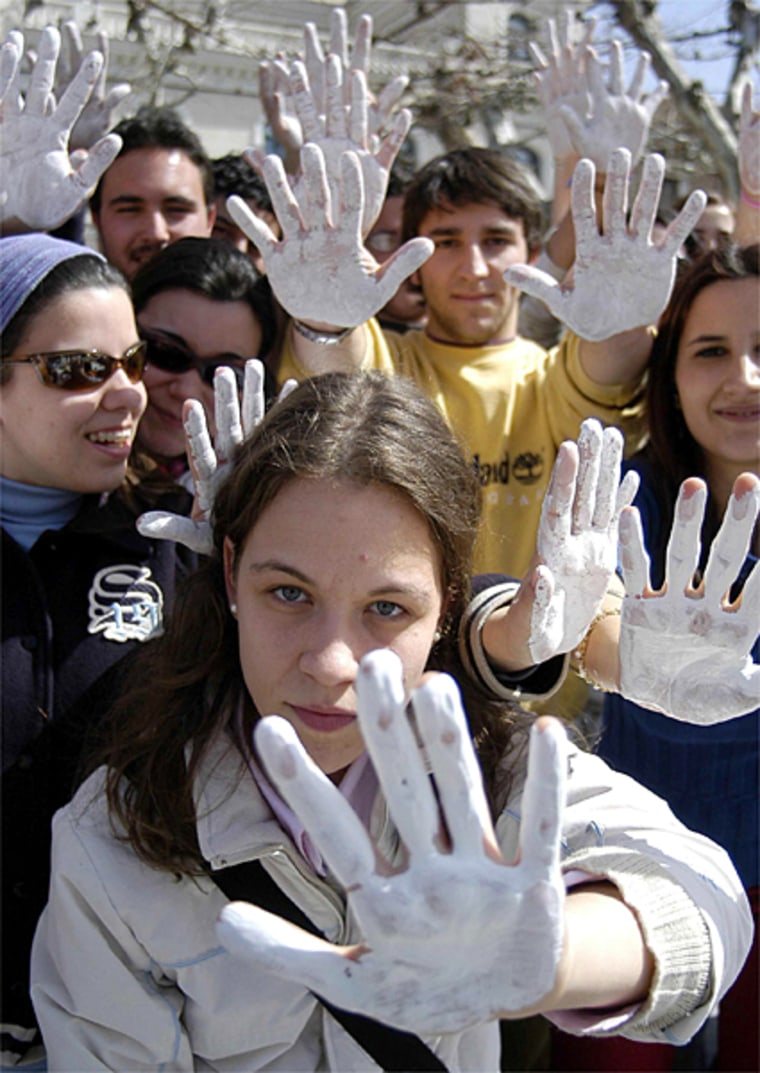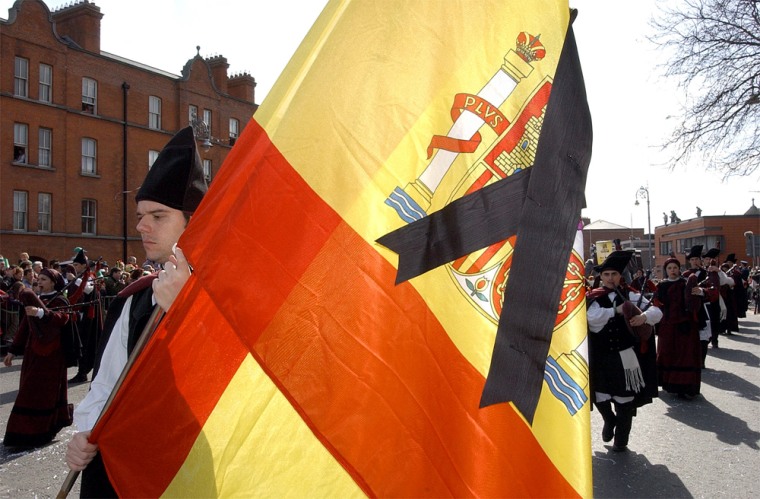They turned up almost immediately after the train bombings in Madrid; a week later, they are everywhere in Spain.
At Atocha train station -- scene of the devastating attacks that killed more than 200 people on March 11 -- and in makeshift memorials littered across the country, amidst the flickering candles and bouquets of flowers were placed white sheets of paper drawn with a single twisted black ribbon.
A day later, loops of black ribbon were everywhere. At demonstrations organized by the Spanish government, people waved huge white banners that shouted “No Al Terrorismo” (No to Terrorism), “Si A La Paz” (Yes to Peace), or “Basta Ya!” (Enough Already), the phrases sandwiched by black ribbons painted onto the cloth.
Spanish flags hanging from balconies and windows bore large black ribbons. People tied or pinned black ribbons to their clothing.
In Barcelona, students formed the shape of a ribbon in a swimming pool. In Pamplona, a shopkeeper who refused to hang a black ribbon in his shop was shot and killed by a policeman.
In neighboring France and Germany, people also wore black ribbons to express their solidarity with Spanish mourners. Even Spanish-language websites like Google Espana have put black ribbons on their homepages.
Old symbol
How did a simple emblem become such a widespread symbol for people opposed to terrorism?
Spaniards say the ribbon has signified anti-terrorism for as long as ETA, the Basque separatist group, existed.
In the northern Basque country, where ETA has been fighting for independence the past four decades, a blue ribbon was first used to show solidarity with families of people kidnapped by the terrorist group. The blue ribbon was specifically adopted for its original meaning of freedom of speech and support for other basic civil rights, according to anti-terrorist organizations like Basta Ya!
The ribbon has had an illustrious history representing freedom from oppression, but it has humble origins.
According to the late historian Gerald Parsons, American folklore has it that a convict told his illiterate family that if they wanted him to come home to put a white ribbon in a big apple tree, which he would see from the train on the way home.
Variations of the returning prisoner theme circulated in the 1960s and 70s, culminating in a hit song in 1972, “Tie a Yellow Ribbon ‘Round the Ole Oak Tree,” performed by Tony Orlando.
Three years later, the wife of Jeb Magruder, who was convicted for his role in the Watergate affair, decorated her porch with yellow ribbons to welcome him home from prison. Yellow ribbons were also tied around trees or houses during the Iran hostage crisis, the first Gulf War, and more recently during the Afghan war.
AIDS ribbon
In fact, the yellow ribbons honoring 1991 Iraq war veterans inspired a group of artists in New York to design the AIDS ribbon.
Visual AIDS, a non-profit organization founded in 1988, was concerned with the way the virus had affected the artists’ community and the growing atmosphere of discrimination and fear surrounding AIDS-affected and HIV-infected individuals.
“We were looking for a symbol to promote not just AIDS awareness but also solidarity with both the victims and caregivers,” said Amy Sadao, executive director of Visual AIDS.
In the end, the Visual AIDS Artists Caucus came up with the enduring shape, described by Sadao as “an inverted V, six inches of ribbon and a safety pin” in the color red for its “connection to blood and the idea of passion.” The ribbon was also, notably, copyright-free. Years later, breast cancer awareness groups co-opted the ribbon shape but in pink.
In Spain, masses of blue ribbons were first seen in 1997, when Miguel Angel Blanco, a local politician, was kidnapped and then killed by ETA. “That was when people went out into the streets using this symbol,” says Jordi Vaquer, a political scientist from Barcelona visiting London.
But last week was the first time Vaquer and his compatriots have seen ribbons in black. Although no one seems to know why black ribbons were used instead of blue, plenty of people will speculate.
Black ribbons have been used in more conventional expressions of mourning in Spain. However, this past week has seen them appropriated to signify a mixture of emotions and politics. Paired with anti-terrorist slogans, the little loops of black have come to denote grief, anger, and a defiance of terrorism.
“[The ribbon] is solidarity with the victims and against terrorism. I think these things are not explicitly explained in the media so everybody understands it but maybe slightly differently,” says Joana Granero, an expatriate Spaniard who works at a publishing house in London.
There are other layers of meaning. “It’s not just a black ribbon. It’s not just a piece of cloth. It’s an appreciation of what happened,” says Dr. Kristina Downing-Orr, a political psychologist at Oxford University. “It’s a way of showing the terrorists that the country or the people are not going to take it.”
White hands
Similarly, many people were seen with hands painted white or holding their palms out at the demonstrations.
White hands became another national symbol in the fight against terrorism in 1997, after a professor from the Autonomous University of Madrid, Francisco Tomas y Valiente, was killed by ETA.

Shortly thereafter, a group of law students donned white gloves or painted their palms white to show they wanted peace. A website called Manos Blancas (“White Hands”) was also set up to report news and information about anti-terrorist demonstrations taking place throughout Spain. The website also acts as a clearinghouse for messages of solidarity and condolences for ETA victims.
But Downing-Orr says that grief symbolism is also a part of the healing process.
Moreover, in a country that has undergone fairly rapid secularization, according to historian Felipe Fernandez-Armesto at Queen Mary, University of London, “Societies desperately need substitutes for traditional ritual. The black ribbon, the lighting of candles, these are examples of the invention of tradition.”
Mass expressions
What’s surprising, however, is the speed with which mass expressions of grief now take place. Downing-Orr attributes the death of Diana, Princess of Wales, with spurring the public phenomenon, when millions of Britons turned out into the streets with bouquets of flowers and photos of the princess who died in a car crash in 1997.
“The public thought they had a vested interest in the grieving for Diana,” says Downing-Orr. “It became a national way of reacting.”
With large-scale tragedies such as the 9/11 attacks or last week’s bombings in Spain come greater expectations of public expressions of grief and solidarity. Especially in the age of the internet and satellite television.
“We’re much more globally aware of these things happening,” Downing-Orr said. “Going out into the streets, wearing a ribbon or having a moment of silence [gives people] an added sense of security, that we’re all in this together. The public grieving really reassures people that we're all in this together.”
“The ribbon has raised different awareness for different issues,” says Sadao. “It’s interesting to see it co-opted for political agendas, which have spawned so many different meanings for the ribbon.”
